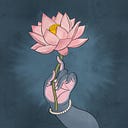Kota Painting Depicting the Apparition of a Tree Spirit

In this unusual symbol-laden painting, an elegant woman, accompanied by a friend, comes to worship a Śiva liṅga placed beneath a tree. She has brought an offering of flowers flowers and holds a small bowl, while her friend offers a garland. A pair of monkeys seated on nearby shrub under the banana plants participate by bending flowers toward the Śiva liṅga, illustrative of all the natural elements in the grove synchronising in order to propitiate Śiva. As she places flowers on the liṅga, one of the trees from a group nearby next to it bursts into bloom. Pairs of white birds wing their way across the sky in front of a large tree that is rich with foliage. The tree mediates between the two women who have come to worship and another of veiled glance, who emerges, arms raised, from a banana plant. This miraculous apparition is a tree goddess (vṛkṣa devata); she will grant the wish of the worshiping woman, whose face is raised toward her. This painting opens a window into the world of popular faith and traditional beliefs, where nature and its vital energy play a central role.
The vṛkṣa devata (tree goddess) motif emerged quite early on in Indian art, especially in sculpture, with particular focus on images of the woman and tree (śālabhañjikā). Synonymous with fertility, prosperity and auspiciousness, śālabhañjikā sculptures are found on Buddhist monuments like the Great Stupa at Sanchi, Madhya Pradesh; on Jain temples in Karnataka; and on Hindu temples all over north and south India.
The śālabhañjikā is a motif which speaks a universal language of desire, passion, fecundity and sexuality. It celebrates the passionate force of nature to procreate. The fully developed image of the forest goddess, vana devata, or the tree deity, vṛkṣa devata evolved from yakṣis, initially seen as youthful forms standing under trees.
Source: Kramrisch, Stella. Painted Delight: Indian Paintings from Philadelphia Collections : Philadelphia Museum of Art, January 26 to April 20, 1986. United Kingdom: Philadelphia Museum of Art, 1986.
__________________________________________
If you find value in my work, I hope you consider becoming a patron or making a contribution to hindu.aesthetic@okicici. Hindu Aesthetic requires a lot of time and effort and your support would mean that I can continue bringing you the best possible content. ❤
